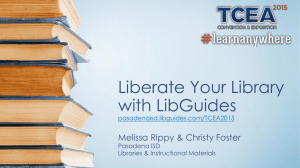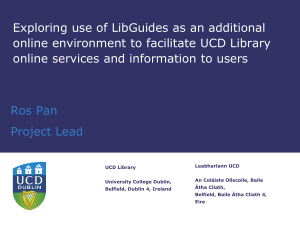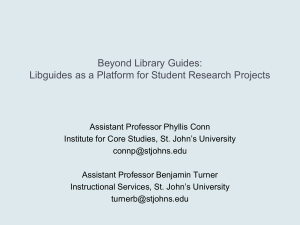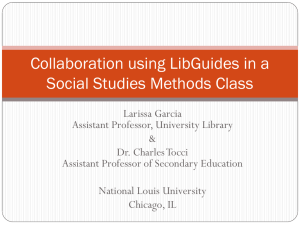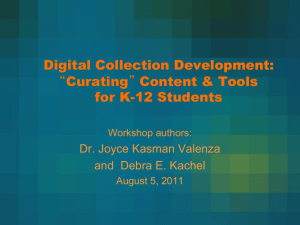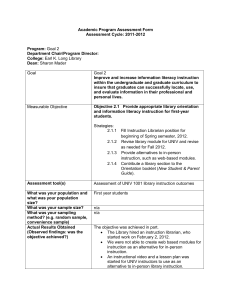Energizing Subject Guide Service with Web 2.0
advertisement
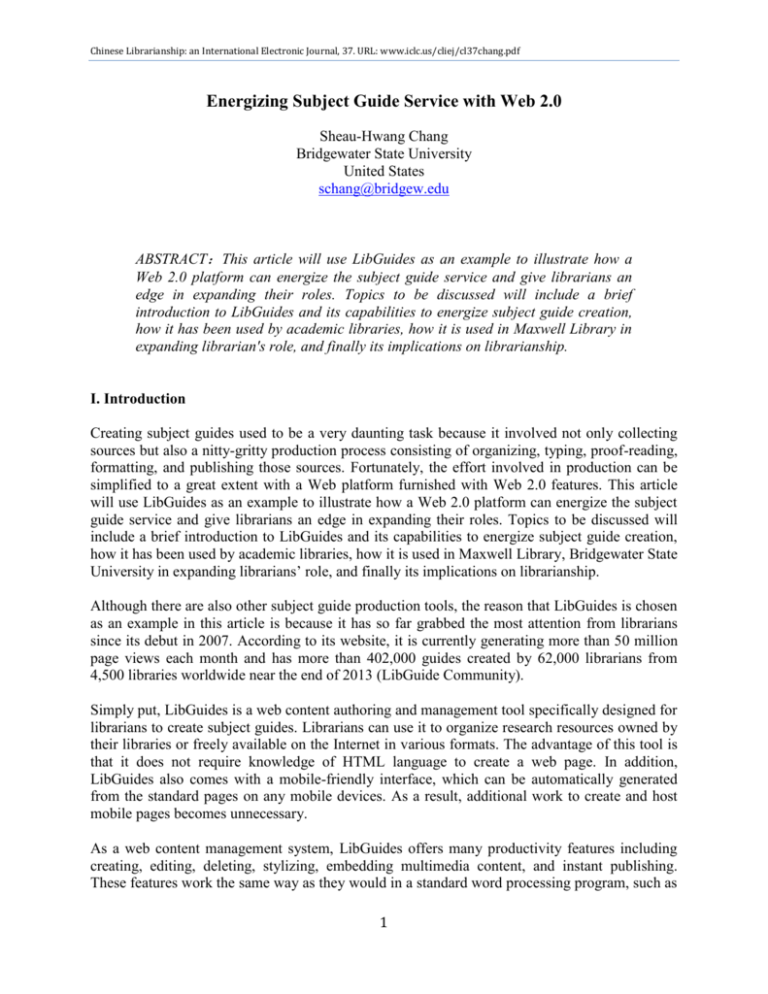
Chinese Librarianship: an International Electronic Journal, 37. URL: www.iclc.us/cliej/cl37chang.pdf Energizing Subject Guide Service with Web 2.0 Sheau-Hwang Chang Bridgewater State University United States schang@bridgew.edu ABSTRACT:This article will use LibGuides as an example to illustrate how a Web 2.0 platform can energize the subject guide service and give librarians an edge in expanding their roles. Topics to be discussed will include a brief introduction to LibGuides and its capabilities to energize subject guide creation, how it has been used by academic libraries, how it is used in Maxwell Library in expanding librarian's role, and finally its implications on librarianship. I. Introduction Creating subject guides used to be a very daunting task because it involved not only collecting sources but also a nitty-gritty production process consisting of organizing, typing, proof-reading, formatting, and publishing those sources. Fortunately, the effort involved in production can be simplified to a great extent with a Web platform furnished with Web 2.0 features. This article will use LibGuides as an example to illustrate how a Web 2.0 platform can energize the subject guide service and give librarians an edge in expanding their roles. Topics to be discussed will include a brief introduction to LibGuides and its capabilities to energize subject guide creation, how it has been used by academic libraries, how it is used in Maxwell Library, Bridgewater State University in expanding librarians’ role, and finally its implications on librarianship. Although there are also other subject guide production tools, the reason that LibGuides is chosen as an example in this article is because it has so far grabbed the most attention from librarians since its debut in 2007. According to its website, it is currently generating more than 50 million page views each month and has more than 402,000 guides created by 62,000 librarians from 4,500 libraries worldwide near the end of 2013 (LibGuide Community). Simply put, LibGuides is a web content authoring and management tool specifically designed for librarians to create subject guides. Librarians can use it to organize research resources owned by their libraries or freely available on the Internet in various formats. The advantage of this tool is that it does not require knowledge of HTML language to create a web page. In addition, LibGuides also comes with a mobile-friendly interface, which can be automatically generated from the standard pages on any mobile devices. As a result, additional work to create and host mobile pages becomes unnecessary. As a web content management system, LibGuides offers many productivity features including creating, editing, deleting, stylizing, embedding multimedia content, and instant publishing. These features work the same way as they would in a standard word processing program, such as 1 Chinese Librarianship: an International Electronic Journal, 37. URL: www.iclc.us/cliej/cl37chang.pdf Microsoft Word. Thus, any librarian who can use a word processor can adopt this tool easily. The best feature, however, is instant publishing. The final product, the subject guide, can easily be published and becomes accessible instantly on the Web. LibGuides also offers many Web 2.0 features including RSS feeds, instant messaging, interactive polls, resource ratings, user comments, customization, institutional branding, sharing, and collaboration. These bells and whistles allow librarians to energize their subject guides with interactive and engaging content, which is not available in traditional subject guides. With these features, LibGuides has become a popular toolbox for librarians to use to serve their users effectively. II. How Has LibGuides Been Used in Academic Libraries? LibGuides has been used by librarians in many ways. At the Schmidt Library of York College of Pennsylvania, LibGuides is being used to host the library website. Verbit and Kline (2011) stated that the ease of use, the ability to brand web domain name, instant updates, scalability, efficient tech support, and the user community were influential factors that led them to choose Libguide as their website’s Content Management System (CMS). The link to the Schmidt Library is http://library.ycp.edu/home. The University of Notre Dame Australia (http://library.nd.edu.au/home) and Cornerstone University (http://library.cornerstone.edu/) are a few other examples (Travis & Tay, 2011). In essence, LibGuides is a tool for teaching and learning. Librarians at the Harvey A. Andruss Library of Bloomsburg University of Pennsylvania are using this tool to host tutorials, delivering library instructions and teaching information literacy skills with embedded self-assessment modules (Yelinek, Neyer, Bressler, Coffta, & Maglios, 2010). The website is accessible at http://guides.library.bloomu.edu/genedtutorial. Jonathan Miner and Ross Alexander (2010), professors of Political Science at North Georgia College & State University, have been using LibGuides to integrate required resources, including newspapers, books, databases, news websites, and writing assignments into the teaching process in the course of Global Issues and the course of American Political Theory. They work with librarians to improve student access to resources, achieve course goals, and help students develop domain knowledge as well as information literacy, writing, and analytical skills. Collaboration is one of the must-have Web 2.0 features and can be accomplished easily with LibGuides. A subject guide author can invite collaborators and grant them equivalent editing privileges so that they can work on the same subject guides and accomplish project goals. The tutorial project of the Harvey A. Andruss Library mentioned above is a collaborative work undertaken by four reference librarians and the government document librarian (Yelinek, Neyer, Bressler, Coffta, & Maglios, 2010, p. 353). However, collaboration doesn’t have to occur by inviting collaborators to edit the same guides. It can be extended to side by side collaboration, that is, the involved parties can create separate and concurrent guides for the same goals. The collaboration between the faculty of the Speech discipline and the librarians at Chattanooga State Community College in Tennessee is an example. The Speech faculty members are given editing rights so that they can create subject guides the way they wish. Both parties, then, work side by side to deliver curriculum and library services to distance education students. The Speech faculty 2 Chinese Librarianship: an International Electronic Journal, 37. URL: www.iclc.us/cliej/cl37chang.pdf use LibGuides to host course-specific YouTube tutorials to enhance their classroom teaching while the Speech librarian creates a course assignment guide and a general Speech resources guide to enhance the educational experience (Roberts & Hunter, 2011). The Speech course assignment guide is accessible at http://LibGuides.chattanoogastate.edu/speechguide and the general speech resources guide is at http://LibGuides.chattanoogastate.edu/speech. Creating subject guides related to academic disciplines and general topics are LibGuides’ initial intent, and it was the most common use for LibGuides in the beginning. Today, course-specific subject guides are attracting more attention from faculty and students (Adebonjo, 2010). Adebonjo described that at East Tennessee State University, public services librarians currently create subject guides not only for library instruction courses but also for courses and course assignments for individual faculty members who request library instruction sessions. This approach ensures that these subject guides will get used. The idea of using LibGuides as a platform for students to work on research assignments was introduced by Phyllis Conn and Benjamin Turner from St. John’s University at the 2010 American Library Association Conference. They take advantage of the LibGuides tab organization feature, organizing subject guides with multiple tabs, using each tab to represent a web page. Each page can have its own content focus, similar to a book chapter or a section in an article. Tabs allow easy navigation as well as integration of resources needed for a given course. In other words, all related resources can be gathered in one place and can be retrieved by clicking on the tab. LibGuides also provides a comment feature that allows instructors and students to send in feedback or comments. The combination of tabbing, commenting, and collaboration features allows Conn and Turner to have their students write, publish, and comment effectively on LibGuides. The details can be found at http://help.springshare.com/conferences. Adding multimedia content to LibGuides is fairly easy. To take full advantage of it, librarians in the Special and Digital Collections at the University of South Florida Libraries chose LibGuides as their web content management system in 2009 and created 14 meaningful and contextualized collection guides to allow visitors and researchers to access digitized objects contained in various types of collections, including digital collections, oral history collections, Holocaust and Genocide Studies Center collections, and many others. Each guide is organized around a theme such as Floridiana, arts collection, etc. (Griffin and Lewis, 2011; Lewis and Griffin, 2011). Event calendars can be posted to LibGuides very easily as well. They can inform visitors about upcoming lectures, workshops, and seminars on various topics related to the collections. Since migrating to LibGuides, the usage statistics collected by LibGuides has shown positive increases. In addition, online exhibits can be assembled easily with the embedding features furnished by LibGuides. Overall, Libguides provides a very sound platform to host special collections with diverse content in diverse formats. The website of the Farid Karam, M.D. Lebanon Antiquities Collection of the USF Libraries is accessible at http://guides.lib.usf.edu/karam. Because LibGuides is built with many Web 2.0-enabled capabilities, it facilitates information sharing. The Electronic Resources Management Team (ERMT) at the University Maryland University College (UMUC) used LibGuides to develop workflow checklists, based on The Checklist Manifesto Principles to effectively manage the complex processes of their yearly electronic resources fiscal transition (England, Fu, & Miller, 2011). The dealings include 3 Chinese Librarianship: an International Electronic Journal, 37. URL: www.iclc.us/cliej/cl37chang.pdf processes of dropped, upgraded, and new subscriptions. Their checklists website is accessible at http://libguides.umuc.edu/content.php?pid=188962&sid=1585877. The checklists technique worked very effectively according to the article, enabling ERMT members to thoroughly understand the interdependence of the workflows involved through the development process. Being able to easily revise and share information among team members with LibGuides was the most important contributor to success for the ERM working team. England and Fu (2011) also published an article on evaluating electronic resources workflow at the UMUC library by using LibGuides in conjunction with their in-house electronic resources management system. This approach allows them to manage the process effectively from a central location. The website is called Electronic Resources Evaluation Central, and can be found at http://LibGuides.umuc.edu/content.php?pid=100107&sid=751324. Although these two sites have not been kept up-to-date, these two articles demonstrate that the platform of LibGuides has potential for non-traditional use. The Grand Valley State University librarians attempted to use LibGuides as an electronic portfolio platform to accommodate their personnel action review process (Harris, Garrison, & Figo, 2009). Although a final decision was pending at that time, it did demonstrate the potential of LibGuides for another example of non-subject guide use. As mentioned in the introduction section, LibGuides currently hosts more than 402,000 guides, which manifests that LibGuides itself is a rich repertoire for research. Some librarians have started to explore it to find ways to improve their library services. Metcalf (2013) used “LibGuides as a tool for collection development by benchmarking peer (Carnegie or other classification) institutions’ reference resource recommendations” (p. 134). Her research method can be adopted for collection development in other subject areas. Stankus and Parker (2013) used LibGuides to conduct a comparative study on the authorship of nursing subject guides, school ranking, essential reference resources for nursing education, and subject guide design. III. LibGuides in Maxwell Library The Maxwell Library at Brigewater State University (BSU), Massachusetts, acquired a LibGuides subscription in 2010. It has been named as MaxGuides, a combination of the library’s name and LibGuides. Its URL is http://MaxGuides.bridgew.edu/. Currently, there are 8 professional librarians in the Maxwell Library, each serving as a liaison to several academic departments. After acquiring LibGuides, a single general instruction session was offered by Technical Services and Digital Services librarians. In the next several months, each professional librarian worked on the LibGuides by themselves, learning its features and trying them out. Then, the contents of the existing 32 disciplinary subject guides were transferred to MaxGuides. The transfer was completed by the end of August, 2010. When the new semester started in September, MaxGuides was introduced to students and faculty. What this demonstrates is that it is not difficult to learn how to use LibGuides. It did not take much effort to master it. Since that time, the subject guides at the Maxwell Library have been expanded from the 32 original subject guides to more than 130 guides. It is obvious that LibGuides has been embraced by the professional librarians and that they enjoy working with it. 4 Chinese Librarianship: an International Electronic Journal, 37. URL: www.iclc.us/cliej/cl37chang.pdf MaxGuides is mainly used as a tool for teaching and learning. Instructional librarians have created subject guides and course guides specifically for the instruction sessions that they teach. Hence, those guides get the most use. Because all professional librarians are liaisons to several academic departments, each also maintains the disciplinary subject guides for those departments. It is very easy to expand existing subject guides with the tools provided by LibGuides. Images, videos, RSS feeds, and other multimedia materials have been added to enhance the look and feel of those guides. Some of the departments have provided links to their subject guides on their departmental home pages. IV. Go beyond a Subject Guide to Expand Librarians’ Role LibGuides is an effective tool for librarians to promote the idea of one-stop shopping for all information related to the constituents of an academic department, including students, faculty, staff, guests, and visitors. As the Mathematics Department’s liaison librarian at the Maxwell Library at Brigewater State University, I maintain and update the Mathematics subject guide. Since moving to the LibGuides platform in 2010, I have been chronicling events sponsored by the Math Club and the Pi Mu Epsilon Mathematics Honors Society. At the beginning, I reached out to the program faculty organizers and asked permissions to take pictures, video-tape lectures, and create web pages in Mathematics subject guide for those events. Fortunately, my efforts were very well received. I, then, extended my outreach to the chairperson and the faculty members of the Department. Through this effort, the original subject guide now has become the Mathematics Department’s resources guide, a central location for information. In addition to the traditional subject content, more topic-specific web pages have been added. They include pages for departmental honors program, for undergraduate research activities, for specific course, and for lectures given by the mathematics faculty and the invited guest speakers. This resources guide has been used as a showcase in the Mathematics Department for prospective, freshman, and transfer students orientation programs to demonstrate the learning and the research opportunities offered to the math students and the accomplishments made by the Department in the summer of 2013. In addition, the most encouraging result is that more collaboration between the library and the Mathematics Department has begun to evolve. These include collaborative collection development, the integration of information literacy into mathematics curricula, and archiving and preserving mathematics historical documents. The mathematics resources guide is accessible at http://maxguides.bridgew.edu/math. Without utilizing the versatile capacity of LibGuides, these could hardly be achievable. The object embedding features provided by LibGuides can inspire innovation. In 2012, I worked with a faculty member who was teaching Asian Theatre. Using SpicyNodes, a social web authoring tool, I created a study guide for that course and embedded it in MaxGuides. The study guide provided an interactive and reflective learning environment for students to learn the materials taught in the class at their own pace. It was well received by the faculty and the students. SpicyNodes is based on radial tree map technology, which allows users to map concepts by constructing a tree with nodes that are Web 2.0 enabled. Web links, images, and videos can be embedded in the nodes to provide instant access to resources needed by students for their class projects. It is worth mentioning that the linked documents can reside in either Blackboard or Moodle courseware. When accessing them, login is required. In this manner, 5 Chinese Librarianship: an International Electronic Journal, 37. URL: www.iclc.us/cliej/cl37chang.pdf copyrighted materials can be protected. This study guide is available at http://MaxGuides.bridgew.edu/asia-thea222. I have used the same technique to create other course-specific study guides. LibGuides is also appropriate for users who are more comfortable with HTML coding and web scripting languages. With my Computer Science education background, I have been able to modify several free Java and jQuery scripts to create custom photo album slideshows and display videos in Lightbox popup settings for users to view. These scripts provide users with a more focused and engaging environment to view content. Their learning experience can certainly be greatly enhanced. Examples can be found on the Math Club event pages at http://MaxGuides.bridgew.edu/mathclub. For some minor academic programs such as Asian Studies and Middle East Studies, I have been using MaxGuides to collect visiting scholars’ lectures while they are on the BSU campus in addition to the standard content. For the Asian Studies Program, for example, we have collected at least 20 lectures since 2010 and most of them are directly related to the course content taught by the Asian Studies faculty. These pages are invaluable resources for students and also an invaluable record representing the growth of the Asian Studies Program at BSU. V. Impact on the Subject Guide Service and Librarianship The many examples given above demonstrate that a Web 2.0 content authoring system can indeed give librarians an edge by energizing their subject guide services with user-centered subject guides that have appealing layouts and enriched interactive contents. In turn, students’ educational experiences can be greatly enhanced. Most importantly, every librarian can grasp this easy to use system quickly to immediately start creating subject guides whenever they wish or at the point of need. Buczynski (2009) described how a Web 2.0 content management system enabled reference staff at Seneca College of Applied Arts and Technology to “work in the same spaces again” to effectively provide their subject guide service. In addition, as LibGuides has become a dominate tool for librarians to create subject guides, a book entitled Using LibGuides to Enhance Library Services: A LITA Guide (Dobbs, Sittle, & Cook, 2013) published by the Library and Information Technology Association contains useful examples to help librarians to use this tool more effectively and productively. A Web 2.0 enabled system also brings about new possibilities to expand librarians’ role, especially as an academic department liaison librarian. It is common for academic departments to host guest lectures, seminars, and events to expand students' educational experience and to share knowledge among faculty from different institutions. Making these events accessible in discipline-specific subject guides greatly expand opportunities for students and others to take advantage of these resources. Collecting, preserving, and sharing this locally created content is an innovative way to augment library resources. In this manner, liaison librarians can act as archivists as well for their liaison departments. Of course, new opportunities also bring about new challenges. Among them, faculty collaboration and the promotion of subject guides have proven the most challenging. Do students actually use the subject guides that librarians have meticulously created? Ouellette (2011) 6 Chinese Librarianship: an International Electronic Journal, 37. URL: www.iclc.us/cliej/cl37chang.pdf pointed out that students use subject guides in only three particular situations, one of which is when “their instructor specifically suggests that they do” (p. 443) use the subject guides. Adebonojo (2010) also observed that at East Tennessee State University, the subject guides created for specific courses with input from faculty members usually get the most use. We have found that to be true with MaxGuides as well. McMullin and Hutton (2010) stressed that promoting subject guides is necessary in order to increase their usage and realize their potential. I would propose that promotion should begin with promotion to the departments and their faculty members. Depending on the campus culture, some campuses do actively encourage and embrace facultylibrarian collaboration while others are more passive in their approach. In the latter case, librarians will need to work harder to develop that collaborative culture as well as to cultivate campus awareness of these valuable library resources. Librarians need to be proactive in promoting subject guide services through e-mail, campus websites, campus messaging systems, and word of mouth. In addition, teaching faculty the benefits of incorporating subject guides in their courses would be the most effective way to promote their use. All in all, outreach, collaboration, and open-mindedness are the keys to the future of librarianship. References Adebonojo, L. G. (2010). LibGuides: Customizing subject guides for individual courses. College & Undergraduate Libraries, 17(4), 398-412. Buczynski, J. A. (2009). Bridging the gap: Online web development platforms enable all reference staff to work on subject guides. Internet Reference Services Quarterly, 14(3-4), 61-66. Dobbs, A. W.; Sittler, R. L.; & Cook, D. (Eds.). (2013). Using LibGuides to enhance library services. Chicago, IL: ALA TechSource. England. L.; & Fu, L. (2011). Electronic resources evaluation central: Using off-the-shelf software, Web 2.0 tools, and LibGuides to manage an electronic resources evaluation process. Journal of Electronic Resources Librarianship, 23(1), 30-42. England, L.; Fu, L.; & Miller, S. (2011). Checklist manifesto for electronic resources: Getting ready for the fiscal year and beyond. Journal of Electronic Resources Librarianship, 23(4), 307326. Griffin, M.; & Lewis, B. (2011). Transforming special collections through innovative uses for LibGuides. Collection Building, 30(1), 5-10. Harris, L.; Garrison, J.; & Frigo, E. (2009). At the crossroads: Bringing the tenure and promotion process into the digital age. College & Research Libraries News, 70(8), 465-468. Lewis, B.; & Griffin, M. (2011). Special collections and the new web: Using LibGuides to Provide meaningful access. Journal of Electronic Resources Librarianship, 23(1), 20-29. 7 Chinese Librarianship: an International Electronic Journal, 37. URL: www.iclc.us/cliej/cl37chang.pdf McMullin, R.; & Hutton, J. (2010). Web subject guides: Virtual connections across the university community. Journal of Library Administration, 50(7/8), 789-797. Metcalf, S. (2013). Good stewards in trying times: Benchmarking peer collections of sociology reference sources using LibGuides. The Reference Librarian, 54(2), 134-142. Miner, J.; & Alexander, R. (2010). LibGuides in political science: Improving student access, research, and information literacy. Journal of Information Literacy, 4(1), 40-54. Ouellelte, D. (2011). Subject guides in academic libraries: A user-centred study of uses and perceptions. Canadian Journal of Information & Library Sciences, 35(4), 436-451. Roberts, S.; & Hunter, D. (2011). New library, new librarian, new student: Using LibGuides to reach the virtual student. Journal of Library & Information Services in Distance Learning, 5(1-2), 67-65. Stankus, T.; & Parker, M. A. (2013). The Anatomy of nursing LibGuides. Science & Technology Libraries, 31(2), 242-255. Travis, T.; & Tay, A. (2011). Designing low-cost mobile websites for libraries. Bulletin of the American Society for Information Science and Technology, 38(1), 24-28. Verbit, D.; & Kline, V. L. (2011). LibGuides: A CMS for busy librarians. Computers in Libraries, 31(6), 21-25. Yelinek, K.; Neyer, L.; Bressler, D.; Coffta, M.; & Magolis, D. (2010). Using LibGuides for an information literacy tutorial. College & Research Libraries News, 71(7), 352-355. Note: Based on a paper originally presented at 2011 CALA 21st Century Librarians Seminar Series held in Kunming, Yunnan, China. Author: Sheau-Hwang Chang, Head of Library Systems, Clement C. Maxwell Library, Bridgewater State University, 10 Shaw Road, Bridgewater, MA 02325, United States. Email: schang@bridgew.edu Submitted to CLIEJ on 27 December 2013. Copyright © 2013 Sheau-Hwang Chang Chang, Sheau-Hwang. (2014). Energizing subject guide service with Web 2.0. Chinese Librarianship: an International Electronic Journal, 37. URL: http://www.iclc.us/cliej/cl37chang.pdf 8
